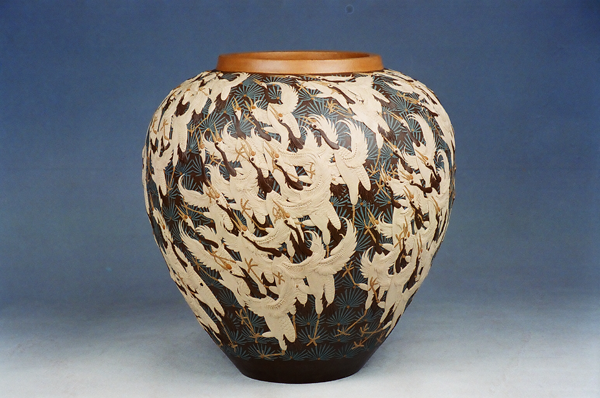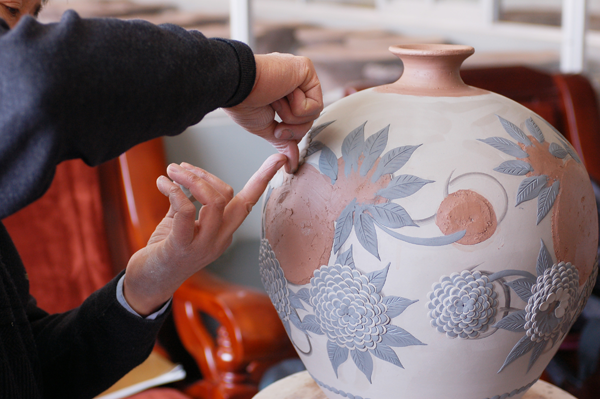 |
| Jun-glazed ceramic work. [Photo provided to chinadaily.com.cn] |
Yixing Jun-glazed pottery historically refers to the earthenware produced in the Jingshan area of Dingshu Town, Yixing, Jiangsu province in the Ming and Qing Dynasty.
The main decorative methods and features of crafts are Jun glaze and embossed decoration. There are two types of Jun-glazed pottery clay body: white and purple; and dozens of under glazes' colors.
The embossed decoration of Jun-glazed pottery also called decal is a unique earthenware decorative skill of Yixing. This craft requires the use of thumbs' and flexible fingering to "twist, twiddle, rub, tap, press" colorful earthenware clay to emboss a beautiful picture on the body of Jun-glazed pottery. Jun-glazed pottery has so many categories and fancy styling; and it is famous for its simplicity, beauty, colorful glaze and long history.
The designs and fabrications of Yixing Jun-glazed pottery absorb copious essence of traditional culture and reach the realm that suit both refined and popular tastes. Jun-glazed pottery combines the ancient and modern cultures and features of the northern and southern earthenware. It not only has the northern earthenware's composed style which is graceful and imposing, but also has the southern earthenware’s elegant feature which is beautiful and neat. Most people refer to Jun glaze, embossed decoration and purple clay as the "Three Superb Things of Yixing".
 |
|
This craft requires the use of thumbs' and flexible fingering to "twist, twiddle, rub, tap, press" colorful earthenware clay to emboss a beautiful picture on the body of Jun-glazed pottery. [Photo provided to chinadaily.com.cn] |
In the late period of the Tang Dynasty, the prototype of the embossed decoration gained more popularity in the making of Yixing Jun-glazed pottery; at the beginning of the Ming Dynasty, the craft of "decal with thumbs" appeared in Yixing Kilns, an indication that the craft had matured. After the establishment of The People's Republic of China, the Yixing Jun-glazed pottery developed rapidly and many varieties have come into existence through innovation and on the basis of traditions.
Yixing Jun-glazed pottery keeps attracting people's attention with its unique artistic charm. It is not only collected by domestic and foreign museums, but also selected as national gifts. Many Jun-glazed pottery artists are often invited overseas for art exchanges and live performances and have won honor's for China.